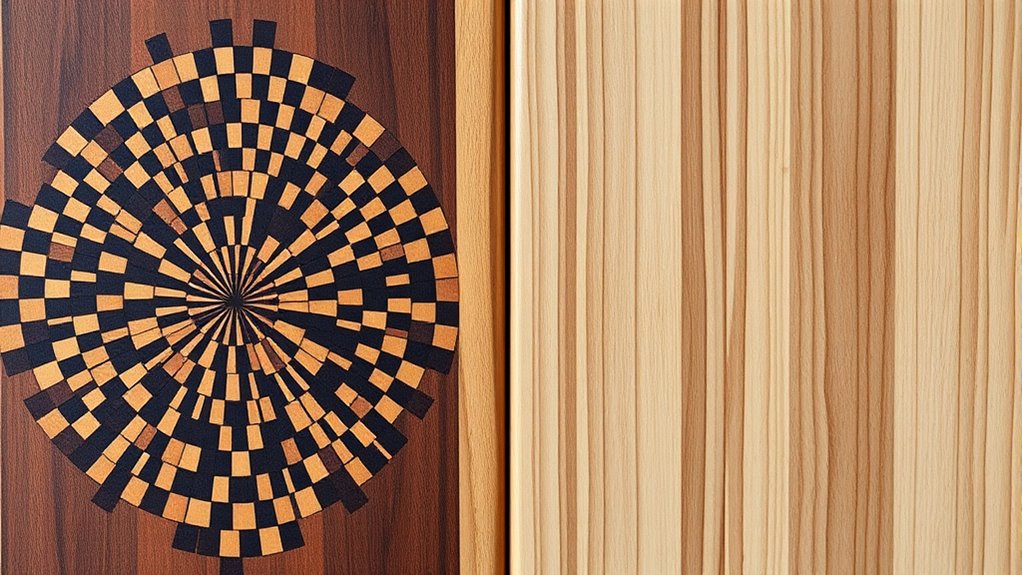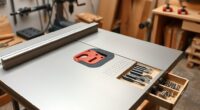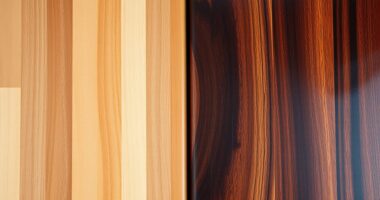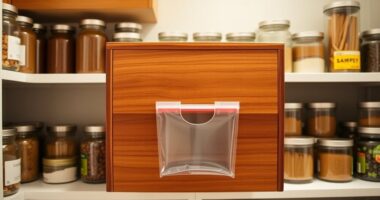If you’re choosing between end-grain and edge-grain cutting boards, consider durability and appearance. End-grain boards are more durable and better at hiding knife marks, making them ideal for heavy use, but they can be heavier and pricier. Edge-grain boards are easier to handle, clean faster, and cost less, though they show wear more quickly. To find out which option suits your kitchen needs best, continue exploring the differences and benefits.
Key Takeaways
- End-grain boards are more durable and better at hiding knife marks, ideal for heavy use and professional kitchens.
- Edge-grain boards are lighter, less expensive, easier to clean, and suitable for everyday home cooking.
- End-grain surfaces absorb impacts, helping knives stay sharper longer, while edge-grain may show marks more quickly.
- Proper maintenance, including regular oiling and careful cleaning, extends the lifespan of both patterns.
- The construction style influences cost, weight, appearance, and suitability for different kitchen needs.
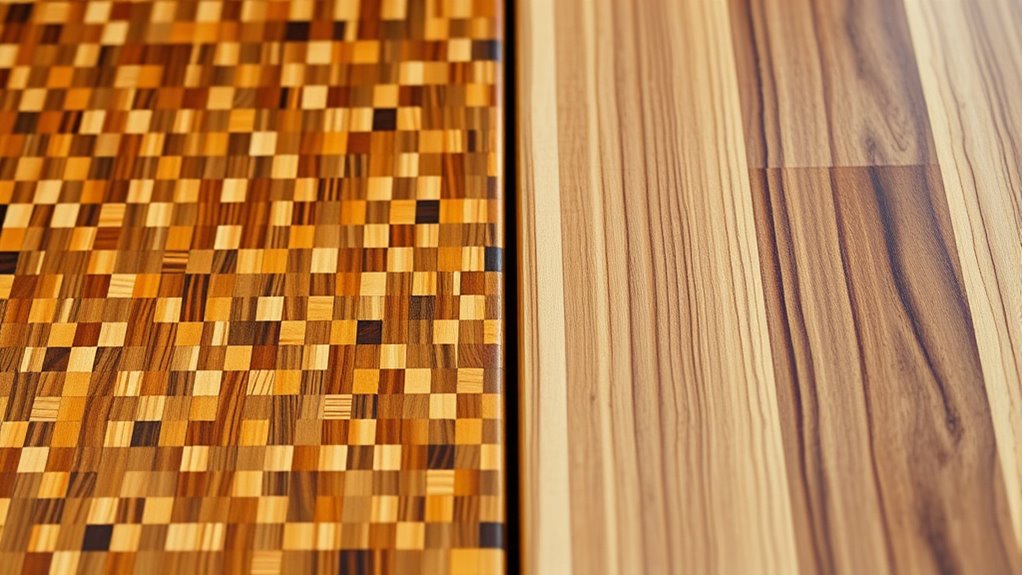
Choosing the right cutting board pattern can elevate both the functionality and style of your kitchen. When deciding between end-grain and edge-grain designs, it’s important to consider how each impacts durability, maintenance, and overall performance. End-grain cutting boards are made by stacking small blocks of wood so that the grain runs vertically. This pattern is renowned for its exceptional wood durability because the surface can better absorb the impact of knives, helping to prevent deep cuts and gouges. This makes end-grain boards a preferred choice for serious chefs and home cooks who want a durable surface that can withstand frequent use. However, maintaining these boards requires some care. Regular oiling with food-safe mineral oil helps prevent the wood from drying out and cracking over time. It’s also best to clean them with mild soap and water, avoiding soaking or harsh chemicals, which can compromise the wood’s integrity. Occasionally, you might need to sand the surface lightly to remove surface cuts and keep the board looking fresh. Additionally, proper storage practices can help extend the lifespan of your end-grain cutting board by preventing warping and damage.
In contrast, edge-grain cutting boards are constructed by placing long strips of wood side by side, with the grain running horizontally. They tend to be more affordable, lighter, and easier to handle. While they may not be as forgiving on your knives as end-grain boards, they still offer a decent level of durability for everyday kitchen tasks. Edge-grain boards usually show knife marks more quickly, which can affect their appearance, but with proper maintenance tips—such as regular oiling and timely cleaning—they’ll serve you well for years. These boards are also easier to clean and often dry faster, reducing the risk of mold or bacteria buildup. Their straightforward construction makes them more resistant to warping if given proper care, which is an essential aspect of maintaining wood durability.
Frequently Asked Questions
Which Cutting Board Pattern Is More Eco-Friendly?
You’ll find that end-grain cutting boards are generally more eco-friendly, especially when made from sustainable materials like bamboo or responsibly sourced hardwoods. They have a lower environmental impact because they last longer and require less frequent replacement. Plus, using sustainably harvested wood reduces deforestation. By choosing an end-grain pattern, you support environmentally conscious practices and minimize waste, making it a smarter, greener choice for your kitchen.
How Do I Maintain Both End-Grain and Edge-Grain Boards?
To maintain your end-grain and edge-grain boards, regularly clean them with mild soap and warm water, then dry thoroughly. Oiling techniques help keep the wood moisturized—apply food-grade mineral oil or beeswax monthly, spreading evenly and allowing it to soak in. Avoid soaking or dishwasher use. Proper cleaning and consistent oiling prevent cracking and warping, ensuring your boards stay durable and safe for kitchen use.
Are There Specific Knives Better Suited for Each Pattern?
Did you know that using the right knife can improve your food prep by up to 30%? For end-grain boards, you’ll want precise knives with fine, sharp blades to protect the dense surface. Edge-grain boards handle slightly more forgiving cuts, so a versatile chef’s knife works well. Focus on knife precision and proper cutting technique to extend your board’s lifespan and optimize your kitchen safety.
Can Pattern Choice Affect Bacterial Growth?
Yes, your pattern choice can affect bacterial accumulation and cleaning effectiveness. End-grain boards, with their tighter surface, tend to resist bacteria better and are easier to clean thoroughly. Edge-grain boards might trap more bacteria in the grain lines, making cleaning less effective. By choosing an end-grain pattern, you help reduce bacteria buildup and improve sanitation, ensuring safer food preparation. Regular, proper cleaning enhances this protection regardless of the pattern.
What Are the Cost Differences Between End-Grain and Edge-Grain Boards?
You’ll find that end-grain cutting boards tend to be more expensive than edge-grain ones because of their higher material cost and intricate construction. The price comparison shows end-grain boards often cost 20-50% more, reflecting the durability and quality they offer. If you’re on a budget, edge-grain boards are more affordable, but if longevity and gentle cutting surfaces matter, investing in an end-grain board might be worth the extra expense.
Conclusion
Choosing between end-grain and edge-grain cutting boards shapes your kitchen experience. Picture slicing through a vibrant mosaic of wood fibers, each pattern offering its own dance of durability and beauty. As you carve and chop, imagine the sturdy end-grain absorbing your efforts, while the sleek edge-grain invites swift, smooth cuts. Whichever you select, you craft more than a meal—you craft a piece of artistry, a proof to your culinary passion and the timeless elegance of wood.
